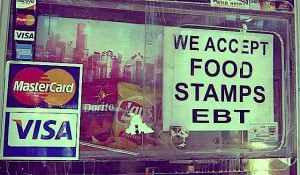California’s food stamp recipients rise by 123% in last decade
PALO ALTO, California –Between 2006 and 2015, the number of California residents receiving food stamps rose 123 percent, from just over two million people to nearly 4.5 million people, according to the latest data on Kidsdata.org. That’s 12 percent of the state’s entire population.
According to the California Department of Social Services, more than half of the state’s food stamp recipients are children.
Los Angeles, San Bernardino, Riverside, and San Diego counties all saw more than 200,000 additional food stamp recipients in the last decade. In Los Angeles County alone, more than half a million new recipients received benefits for food stamps during this time period.
While it’s no surprise that more Californians would sign up for food stamps during the Great Recession between 2007-2009, the question remains: Why has the number continued to rise in the five years since the recession ended?
Although unemployment rates have fallen, “the historical record shows that declines in poverty and [food stamp] enrollment typically lag behind improvements in the unemployment rate following recessions,” according to an article published recently by the Center on Budget and Policy Priorities. Another major factor is that in 2008, Congress permitted states to relax their eligibility standards for the national food stamp program.
Article continues after this advertisementResearch shows that food insecurity can seriously affect children’s cognitive and physical development. Hunger can also hinder school attendance, academic achievement, graduation rates, and job readiness.
Article continues after this advertisementCurrently, hunger relief advocates are asking Congress to pass a strong Child Nutrition Reauthorization Act, which would provide nutritious food to children at school, in child care, and during weekends and school holidays, and to strengthen the federal Supplemental Nutrition Assistance Program (SNAP) that provides food for 45 million low-income Americans (PDF).
Other policy recommendations include making it simpler and less stigmatizing for students to access free and reduced-price school meals and ensuring the availability of nutritious, appealing foods at school meals without competition from less healthy foods.
Like us on Facebook
